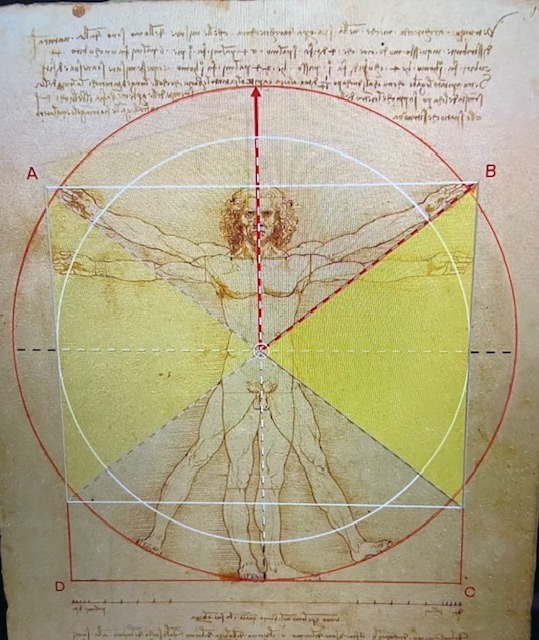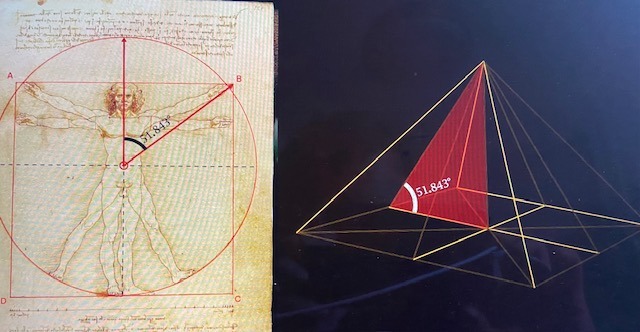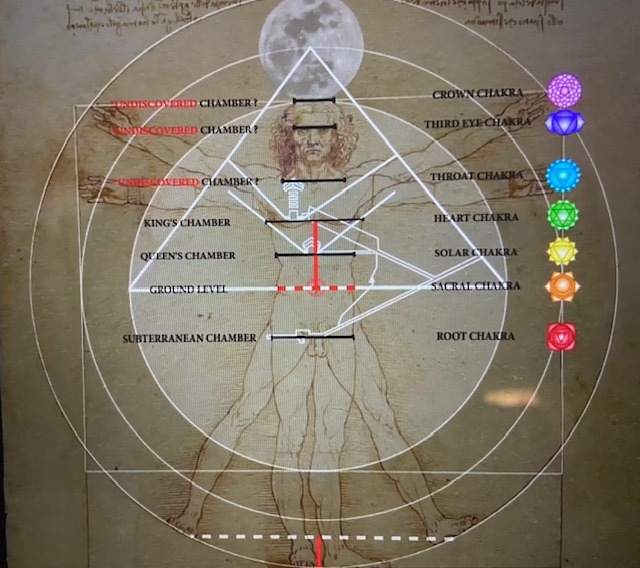The Real Da Vinci Code
explore the secret Code of the Vitruvian Man


Who are we, and what is our purpose? The narratives of history often diverge from our lived reality. Could it be that our entire life journey is building towards a greater revelation? And if so, how do we uncover it? The Real Da Vinci Code
Leonardo da Vinci, a luminary born in 1452 in Italy, stands as a pinnacle of polymathic genius in history. His prowess extended across multiple domains, including cryptology, where he demonstrated exceptional skill. Among his 20 masterful paintings, the Mona Lisa captivates with its enigmatic aura, while the Vitruvian Man remains an enduring symbol of his intellectual depth.
In his quest to square the circle, Da Vinci delved into the profound symbolism of geometric fusion. The circle, representing the feminine, intertwines with the square, symbolizing the masculine, encapsulating the unity of consciousness. This ancient concept, dating back to Greek antiquity, posited that achieving this geometric harmony could unlock transcendent states of awareness. However, Da Vinci's portrayal, though symbolically rich, falls short of mathematical precision. While he ingeniously positions the square, aligning it with the tangent of the circle's base, it fails to precisely match the circle's area. Da Vinci's legacy extends beyond artistry, as evidenced by his seminal work "Divina Proportione." In this treatise, he meticulously dissects the Golden Ratio's implications for geometry, underscoring its profound influence on visual arts, perspective, and architecture. His profound grasp of proportion reverberates through his exploration of geometric principles, shaping the contours of scientific inquiry for generations to come. However, despite his expertise, Da Vinci's attempt to square the circle, as depicted in his work, did not yield a precise match in terms of area. Leonardo Da Vinci is renowned not only for his artistic brilliance but also for his enigmatic writing style, often characterized by backward mirrored text. This unconventional approach was not arbitrary; it is believed that Da Vinci employed this technique to conceal his ideas from the scrutiny of the Roman Catholic Church, whose doctrines often clashed with his own observations and beliefs. By encrypting his writings, he shielded himself from potential persecution.
Delving deeper into his works, such as the iconic Vitruvian Man drawn in 1490, reveals hidden layers of encryption. Despite being one of the most recognized images in history, few have realized that Da Vinci embedded within it the profound knowledge of the Great Pyramid of Giza. This revelation adds another dimension to Da Vinci's genius and underscores the intricacies of his encoded messages, waiting to be deciphered by those willing to explore further. In Leonardo da Vinci's depiction of the Vitruvian Man, an intriguing correlation emerges between the angle formed from the naval to the top corner of the square and the side slope of the Great Pyramid. This angle aligns precisely with the slope of the Great Pyramid, measuring approximately 51.843 degrees. Cryptologist Alan Green's analysis sheds light on this fascinating connection, revealing the meticulous attention to detail and mathematical precision employed by da Vinci in his iconic masterpiece. It's widely known that the Great Pyramid embodies the ratio of the radiuses of Earth and Moon. In the examination of Leonardo da Vinci's Vitruvian Man, an intriguing correlation emerges between the proportions depicted and celestial geometry. By inscribing a circle within the square encompassing the figure, aligning its center with the man's naval, and rising the circle, a remarkable revelation comes to light. This configuration not only reveals six perfect pyramid cross sections but also unveils an exact geometric correspondence with the Earth-Moon-Great Pyramid relationship. The ratio between the radius of the Earth, the radius of the Moon, and the height of the Great Pyramid of Giza is a subject of significant interest. Researchers have noted that in da Vinci's Vitruvian Man, the placement of the circle within the square and its alignment with the figure's naval corresponds precisely to this ratio. This observation suggests a deliberate encoding of celestial proportions within da Vinci's masterpiece, showcasing his profound understanding of geometry and cosmology. This finding underscores the multifaceted nature of da Vinci's work, where artistic expression intertwines with scientific inquiry. It invites further exploration into the depths of his genius and the intricate connections between art, mathematics, and the natural world. In Leonardo da Vinci's Vitruvian Man, the figure is divided into 14 sections, demonstrating precise integer proportions. Interestingly, da Vinci also reduces the height of the Vitruvian Man by 1/14, which serves as a subtle nod to the myth of Horus and Seth. According to Egyptian mythology, Horus's brother Seth murdered him by dismembering his body into 14 parts.
This parallel between da Vinci's depiction and the ancient myth adds depth to the symbolism encoded within the Vitruvian Man. it underscores the intricate layers of meaning embedded in da Vinci's art, inviting deeper exploration into the connections between mythology, mathematics, and the human form. The Rhind Papyrus, a significant ancient Egyptian mathematical document, was discovered in the Great Pyramid of Giza in the 19th century. Named after the Scottish antiquarian Alexander Henry Rhind who purchased it in 1858, this artifact provides invaluable insights into the mathematical knowledge of ancient Egypt. Dating back to around 1650 BCE during the Second Intermediate Period, the Rhind Papyrus contains various mathematical problems, including arithmetic, geometry, and unit conversions. It offers detailed instructions on calculations related to areas, volumes, fractions, and even complex algebraic equations. One notable section includes a method for calculating the volume of a truncated pyramid, which reflects the practical architectural knowledge of the time. The Rhind Papyrus offers insight into the construction of the Great Pyramid of Giza, revealing the seked, or unit of measurement, utilized during its creation. This unit was equivalent to five palms and two fingers per cubit. Employing this measurement, the slope of the pyramid's face was precisely set at 14/11, reflecting the mathematical relationship known as phi. Additionally, the inverse slope of the pyramid's edges corresponded to 9/10, representing the mathematical value of pi. By incorporating these advanced mathematical formulas, the builders of the Great Pyramid ensured its structural stability. This unique combination of phi and pi ratios provided a level of stability not found in other pyramids in the Giza region. The utilization of such precise mathematical principles underscores the advanced engineering and architectural knowledge of the ancient Egyptians. Thus, the Rhind Papyrus serves as a testament to the ingenuity and sophistication of ancient Egyptian civilization in mastering mathematical concepts for monumental construction projects. At the heart of the Giza Plateau lies a remarkable numerical constant: 51.843 degrees. This figure, meticulously encrypted by Da Vinci within his iconic Vitruvian Man, underscores the depth of his understanding regarding the Great Pyramid of Giza. Positioned with deliberate intent, the Vitruvian Man gestures towards this critical angle, indicative of Da Vinci's profound insight into the architectural and geometric principles governing the pyramid's design. Da Vinci's cryptic incorporation of this angle, evident in the positioning of both hands of the Vitruvian Man, speaks to the intricate web of knowledge he possessed. It suggests an intimate familiarity with the mathematical intricacies underpinning the Great Pyramid's construction and serving as a testament to Da Vinci's intellectual acumen and his ability to grasp the esoteric secrets of ancient architecture. The significance of 51.843 degrees extends beyond mere numerical coincidence, hinting at a deeper understanding of sacred geometry and cosmic harmony. Da Vinci's subtle homage to this angle within the Vitruvian Man invites contemplation of the interconnectedness between human anatomy, celestial phenomena, and the enduring mysteries of ancient civilizations.
The Codex Atlanticus stands as a compendium of Leonardo da Vinci's myriad sketches, representing a treasure trove of his intellectual pursuits. Within its pages lies a remarkable testament to Da Vinci's multifaceted genius, offering insights into his diverse interests and engagements. One notable feature is a prefatory letter addressed to the "Devatdar of the Lieutenant of the Sultan of Cairo, Babylon," shedding light on Da Vinci's purported association with Sultan Quaitbay, renowned for his intellectual prowess and architectural legacy in Cairo. Da Vinci's missive not only alludes to his purported arrival in Cairo but also delves into his fascination with the Great Mount Taurus. His meticulous documentation unveils a profound exploration of this geographical landmark, along with vivid accounts of his foray into its enigmatic chambers. This expedition, captured in meticulous detail within the Codex Atlanticus, underscores Da Vinci's insatiable curiosity and his relentless pursuit of knowledge. Moreover, the Codex Atlanticus serves as a repository of Da Vinci's scientific inquiries, encompassing a wide array of subjects ranging from anatomy and engineering to astronomy and botany. Its pages offer a glimpse into the mind of a visionary polymath, whose inscriptions and sketches continue to inspire awe and admiration centuries after their creation. Bull Mountain, also known as Mount Taurus, has garnered significant attention in the realm of archaeological and historical discourse, particularly due to its purported connection to the Great Pyramid of Giza. Mount Taurus has been proposed as the true identity of this iconic structure. This hypothesis is rooted in the meticulous observations and interpretations of renowned polymath Leonardo da Vinci, who made explicit references to Mount Taurus in his writings, including the Codex Atlanticus. Da Vinci's keen insights into the architectural and geographical landscape of ancient Egypt have sparked considerable interest among scholars seeking to unravel the mysteries surrounding the construction and purpose of the Great Pyramid.Originally known as Bull Mountain or Mount Taurus, the Great Pyramid of Giza holds profound significance in ancient Egyptian mythology, particularly in its association with Apis or Hapi, the principal bull deity of Egypt. Leonardo da Vinci's writings offer intriguing insights into the symbolism and significance of Bull Mountain, revealing a deeper understanding of the structure's cultural and metaphysical importance. In his observations of Mount Taurus, da Vinci described its towering peaks as reaching skyward, symbolizing a connection between the earthly realm and the heavens above. He noted the strategic orientation of the mountain, where the rays of the sun illuminated its eastern face hours before dawn, attributing a sense of divine radiance to its formidable presence. Da Vinci's meticulous observations hint at a reverence for the spiritual and symbolic dimensions of Bull Mountain, suggesting that its significance transcended mere physical stature. Moreover, da Vinci's writings imply a deeper, esoteric understanding of the Great Pyramid, hinting at hidden meanings and sacred geometries embedded within its architecture. By delving into the fractal intricacies of his accounts, scholars uncover layers of symbolism and metaphysical insights that illuminate the profound mysteries surrounding the Great Pyramid and its enduring legacy. Mount Taurus, also known as Rostau in ancient Egyptian mythology, holds profound significance in the esoteric traditions of the Rosicrucians, symbolizing a sacred nexus of spiritual and metaphysical energies. In Rosicrucian symbolism, Rostau serves as a focal point for initiatory rites and mystical practices, embodying the transformative journey of the soul towards enlightenment and transcendence.
The association of Mount Taurus with the Ross Cross, a sacred emblem of the Rosicrucian Order, underscores its importance as a symbol of divine illumination and spiritual awakening. The Ross Cross, often depicted as a cross with a rose at its center, represents the integration of earthly and celestial energies, embodying the alchemical process of spiritual regeneration and enlightenment. Furthermore, the Rosicrucians revered Mount Taurus as a sacred landscape imbued with mystical energies and cosmic vibrations. Its alignment with celestial bodies and ley lines amplifies its significance as a locus of spiritual power and esoteric knowledge, drawing seekers of wisdom and enlightenment to its sacred slopes. Through their esoteric teachings and initiatory practices, the Rosicrucians seek to unlock the hidden mysteries of Mount Taurus and its connection to the human soul's journey towards spiritual evolution. By delving into the symbolic language of ancient mythology and mystical traditions, practitioners of the Rosicrucian path endeavor to unveil the profound truths encoded within the sacred landscape of Mount Taurus, guiding aspirants on the path to inner illumination and divine union. The ancient name for the Giza Plateau was not Giza but Ros-tau, often referred to as the Rose Cross. In a letter attributed to Leonardo da Vinci, there are encrypted messages containing esoteric wisdom and insights accessible only to those who comprehend the connection to the "alpha," symbolizing the bull deity associated with the Great Pyramid. The symbolism of "alpha and omega," depicted on the sarcophagus, along with the precise 51.843-degree slope angle encrypted within the Vitruvian Man, alludes to a deeper significance beyond conventional understanding. The sarcophagus with the inscriptions "Alpha" and "Omega" is located in the King's Chamber of the Great Pyramid of Giza. This chamber is positioned at the heart of the pyramid, precisely aligned with the pyramid's apex and the pyramid's external surface. The King's Chamber is a significant architectural feature within the pyramid, believed to have held the pharaoh's sarcophagus. The inscriptions "Alpha" and "Omega" symbolize the beginning and the end, suggesting profound cosmic and spiritual significance. These inscriptions have sparked various interpretations, with some associating them with themes of eternity, divinity, and the cyclic nature of existence. The Great Pyramid offers another perspective when we consider that each base side measures between 755 and 756 feet, aligning with the square referenced in Da Vinci's Vitruvian Man. By using the height of the Great Pyramid as a reference point to determine the radius of a circle, we gain insight into its dimensions. With this approach, we find that the height of the Great Pyramid corresponds to 481 feet or 280 cubits, while the side of its base measures 756 feet or 440 cubits. Remarkably, these measurements align precisely with the proper squaring of the circle, where the perimeter value matches the circular circumference value. Da Vinci's lines on the Vitruvian Man reveals a perfect blueprint of the internal structure of the pyramid chambers , only the Queen's chamber seems to be missing, but is it? Queen Isis is mourning the cutting off her husband's body into 14 parts , representing the 14 phases of the waning moon. Her reconstructing Osiris's body represents the 14 phases of the waxing moon. Da Vinci has precisely identified the known subterranean Queen's and King's chamber, the grand level of the pyramid, its defining side angles and its mathematical relationship to Earth and Moon. Which leads to the question do these upper lines in the Vitruvian Man image represent presently unknown chambers?
The Vitruvian Man is a blueprint of man's unfolding spiritual journey through the sacred energy centers of the spine known as CHAKRAS. Perhaps finding these inner chambers in ourselves is our ultimate purpose and the Great Pyramid but a metapher for the true measure of mankind. Every line in the image encrypts important locations of the Great Pyramid itself . These lines within the image point not only to the chambers within the Pyramid but to other chambers still to discover. A big void was identified by a team of Japanese researchers in 2017, using ground penetrating radar which can sense density changes inside large rock structures. This void space is located at the Grand Gallery of the Great Pyramid appears to lead exactly to the Throat Chakra- line on the Vitruvian Man-image. Indicating that where Da Vinci has left another horizontal line on the Vitruvian Man's body might be leading us to the precise location of another chamber. Additional there are two other lines at the forehead , the pineal glandand the Crown Chakra. Furthermore are lines on the Vitruvian Man's image on both knees, potentially pointing to other chambers. Leonardo Da Vinci gives aother encryption in his backward mirrored texts where he references 1/14 (which is referred to Osiris's mythology where Seth cuts his brother's body in 14 parts). Da Vinci does the same by separating the body of the Vitruvian Man in 14 different places. At the place of the 1/14 separation of the Vitruvian Man down at the base of the circle and the center of the square over thtat circle, it will give us the exact location of the placement of the square. Proportionally that would give us the same area value as the circle .
Thus fulfilling the ancient mystery that is believed to be impossible: to square the circle without measurements whatsoever , using only a compass and a straight edge.. Maybe the Great Pyramid is a reflection of our own conscious progression . As we are around to understand more about our own Selves and consciousness is expanding through each of our Chakra centers. Maybe we will understand more about this reflection that we call the Great Pyramid




